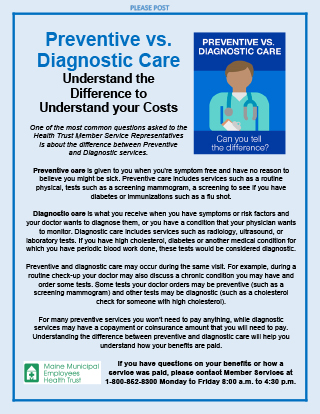Preventive vs. Diagnostic Care

One of the most common questions asked to our Member Service Representatives is about the difference between Preventive and Diagnostic services.
Preventive care is given to you when you’re symptom free and have no reason to believe you might be sick. Preventive care includes services such as a routine physical, tests such as a screening mammogram, a screening to see if you have diabetes or immunizations such as a flu shot.
Diagnostic care is what you receive when you have symptoms or risk factors and your doctor wants to diagnose them, or you have a condition that your physician wants to monitor. Diagnostic care includes services such as radiology, ultrasound, or laboratory tests. If you have high cholesterol, diabetes or another medical condition for which you have periodic blood work done, these tests would be considered diagnostic.
Preventive and diagnostic care may occur during the same visit. For example, during a routine check-up your doctor may also discuss a chronic condition you may have and order some tests. The tests your doctor orders may be preventive (such as a screening mammogram) and other tests may be diagnostic (such as a cholesterol check for someone with high cholesterol).
For many preventive services you won’t need to pay anything, while diagnostic services may have a copayment or coinsurance amount that you will need to pay.
Understanding the difference between preventive and diagnostic care will help you understand how your benefits are paid. If you have questions on your benefits or how a service was paid, please contact Member Services at 1-800-852-8300 Monday to Friday 8:00 a.m. to 4:30 p.m.
